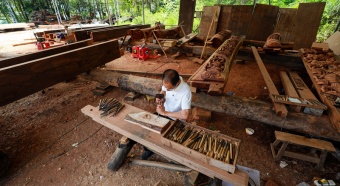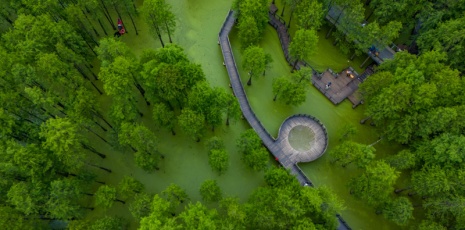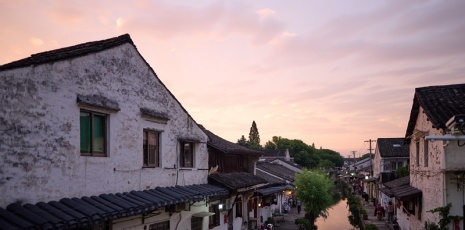Walking on the road or sitting in the car now, you can see multiple new houses standing high on both sides of the road in the village. Decorated with various colored tiles, the houses were different in shape, with some pillars and roofs carved so finely that it is difficult to tell whether it’s city or countryside. This is in sharp contrast with the situation of a few decades ago. In the mid-1970s, I went to the Linchi Farm (60 kilometers away from Ningdu County) to participate in farmland works. Every time I went back to the county by car, I saw rows of adobe houses in tatters. Brick houses were rarity of the rarities.
A friend of mine was crowded in three low-rise adobe houses in Xu Town with his five family members. It is known that this house was built by his ancestors during Qianlong period of the Qing Dynasty. Of real “dirt” nature, the house had damaged and leaking walls and roof. During heavy-rainy days, the house inside also rained; during thunder and lightning days, the whole house was moving.
After the reform and opening-up, the rural land contract system was implemented, increasing people’s income and thereby fueling their desire for new houses.
At that time, new houses were still of “dirt” nature. Made of mixture of smashed soil and a certain amount of straw, those self-made bricks were put into a special square lattice, and then pressed and dried for use. Materials for windows, doors and beams were possibly from mountain woods or old houses. There was basically no labor cost then, as friends and relatives would come to help just for a dinner. Though it only took a few hundred yuan to build such a “brick” house in the late 1980s and early 1990s, the process was still back-breaking. The newly built house looked quite unique compared with the surrounding houses. The whole family was so delighted that his father proudly said to me that he had completed his life-long pursuit.
As the reform and opening-up deepens, favorable rural policies mushroomed, such as abolished agricultural tax, grain subsidies and agricultural machinery purchase subsidies. Villagers’ income thus increased, so did new houses. The newly built brick houses have dwarfed my friend’s house.
After the 18th National Congress, in accordance with the spirit of the “State Council’s document on supporting the revitalization of former Central Soviet Areas such as southern Jiangxi”, Jiangxi has prioritized renovation of rural dilapidated adobe houses for revitalization of the southern Jiangxi Soviet Area. They have set different subsidy standards for differing targets, namely, 15,000 yuan for ordinary farmers, 20,000 yuan for low-income households, and 40,000 yuan for survivors of martyrs, massively stimulating people’s building enthusiasm. In the past few years, new buildings have risen one after another. Most villagers have built reinforced concrete houses of different shapes. My friend’s family also pulled down their adobe house and built a three-storey building.
New perceptions and habits have come along with those spacious and clean new houses in the countryside. The original toilet was in thatched room or pigsty, generating a bad-smelled atmosphere filled with stinking mosquitoes. Yet now, clean and sanitary, the indoor bathroom is equipped with deodorant and flushing devices. And most households have built biogas digesters turning excrement into treasure. Biogas has become a good clean fuel, and biogas water and slag are high-quality organic fertilizers that produce green food. It is worth mentioning that the original rural houses were most ragged and dangerous, yet now, the firm and beautiful new houses are surrounded by trees and flowers, altering rural appearance and improving rural residents’ living quality.
Building new houses is a long-cherished pursuit for farmers. In the past, brick house was a luxury, yet now, steel-concrete composite structures become quite common. From old to new, from simple to luxurious, rural houses reflect enhancement of people’s living standards and senses of happiness and gain, as well as fruits of the reform and opening-up, highlighting the profound affection of the party and the government for people’s livelihood since the 18th National Congress.









